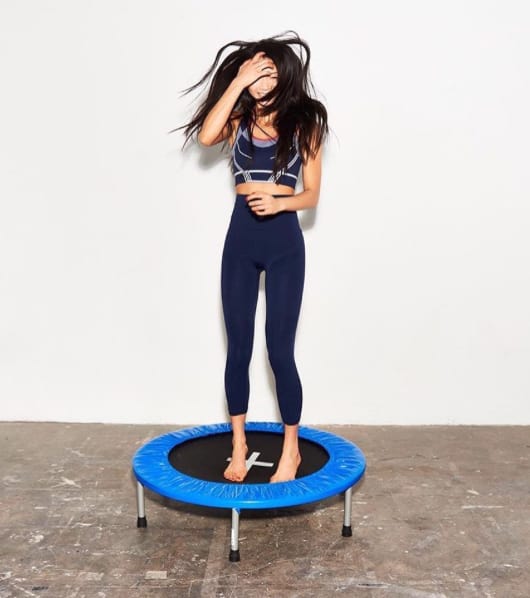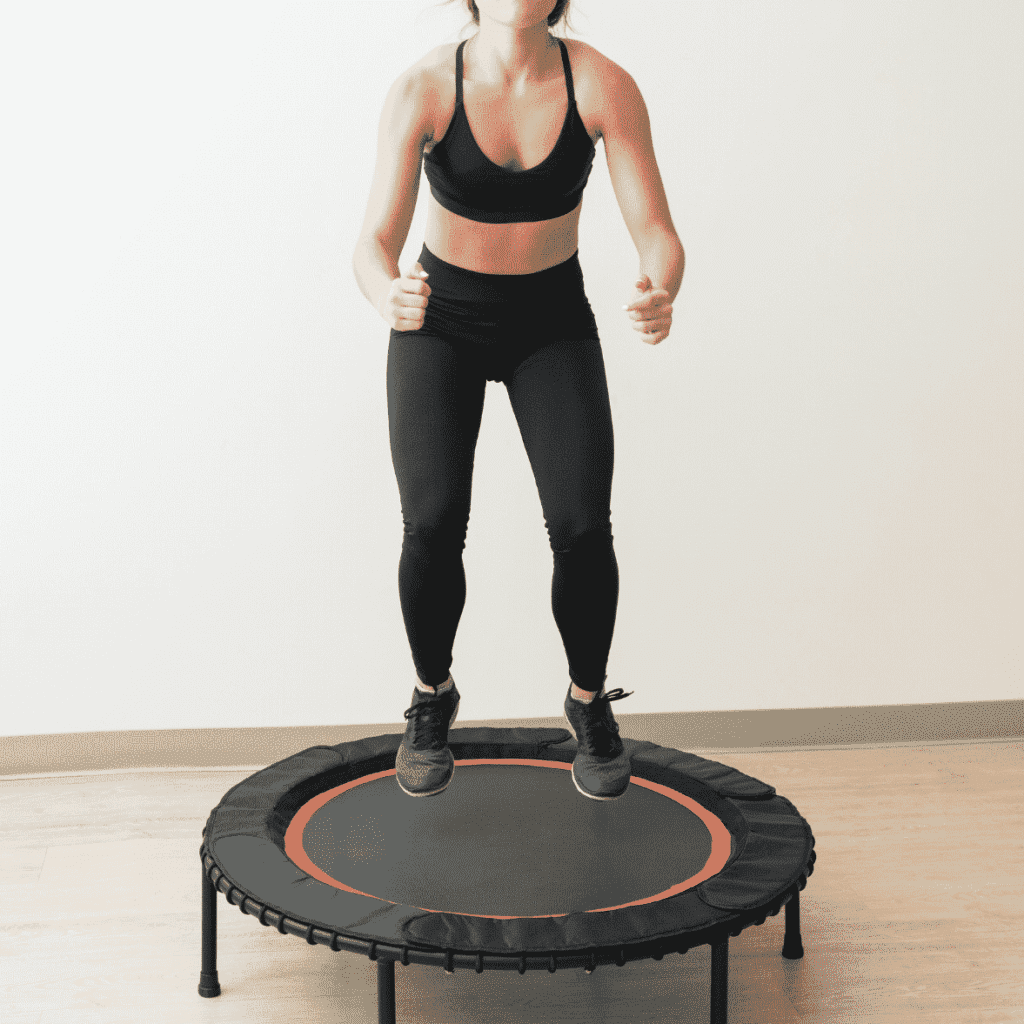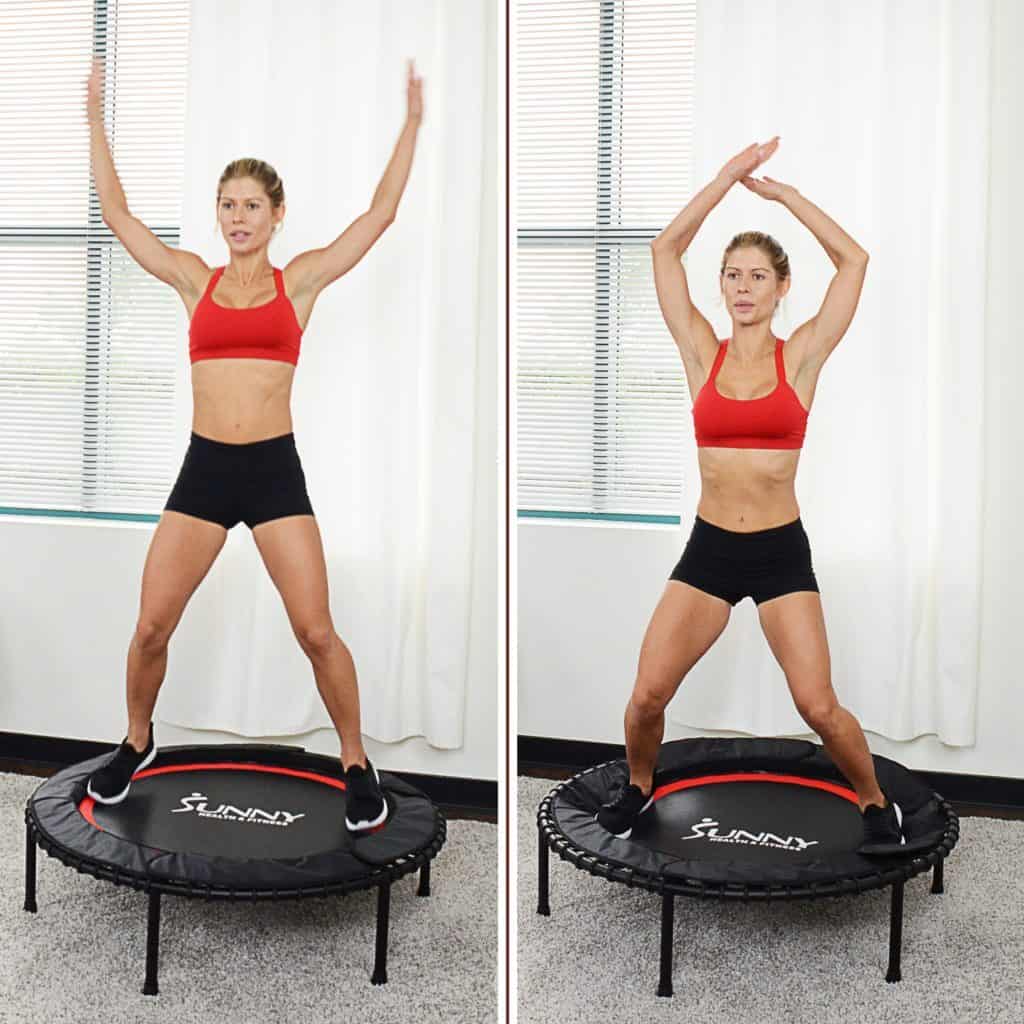Is Rebounding Bad For Your Back?
Rebounding is a popular form of exercise both at home and in the gym. It’s quite gentle on your body, as it allows you to perform exercises with little to no impact. If you are a senior with back problems, check our comparison article on the best rebounders for seniors.
But, that doesn’t necessarily mean it’s 100% good for you. As with any other exercise, safety and starting fitness are vital if you want to get the most out of rebounding.
You might be wondering, is rebounding bad for your back? It’s an understandable concern and is what we’ll address in this article.
Ready to start your rebounder weight loss journey? Try out our 8-week rebounder program!

Is Rebounding Bad for Your Back? Rebounding is not bad for your back because it’s considered a low impact exercise which doesn’t put any pressure on the spine or joints. Rebounding even strengthens the muscles in the back through the downward force placed during each bounce. But this is providing you’re fairly healthy when you begin. By this, we don’t mean your fitness level but are referring to any existing conditions you might have.
Are Trampolines Bad for your Back?
Trampolines can be bad for your back. Specifically, rebounding can be problematic for and people who should not use a rebounder with conditions like sciatica, spinal fractures, or pinched nerves. This isn’t always the case though, so speak to a health professional before you try rebounding.
Also, rebounding can result in sudden, jerking movements if your form isn’t correct. This can cause injuries ranging from pulled muscles to trapped nerves. Of course, this is true of any exercise, so just make sure you’re rebounding properly.
Is Rebounding Good for spine?
Jumping on a trampoline is considered a low-impact exercise, meaning it puts very little pressure on your joints and spine. Something like running can be high-impact because your body absorbs the shock every time your foot hits the ground. Therefore rebounding is a very good option for your spine.
Combining rebounding with different exercises, such as jogging, jumping jacks or weights can be a good way of easing pressure on your spine if you already have back pain.
Spine Compression
For an added bonus you can stretch your back out before and after on this spine stretcher which helps decompress the spine in preparation for your rebounder workout:
Effects of Rebounding on the Spine
Rebounding is generally a positive form of exercise because it’s easy on the joints. Here’s a quick roundup of the main positive effects of rebounding on the back:

Can Rebounding Hurt Your Lower Back?
Rebounding can help to relieve lower back back because the mat takes a lot of the impact. Unlike other forms of exercised. However if you have lower back pain test out how it feels. If it’s sore to use the rebounder, take a step off. But if you don’t have any existing pain it can be incredibly beneficial for your lower back. Lets look at some of the benefits to your lower back.
Benefits of Rebounding on Lower Back Pain
Strengthens muscles
Jumping is a surprisingly good form of exercise for strengthening muscles. Not only does it work your legs when jumping, but it also works your core as you try to maintain balance and brace for impact.
Much like swimming, rebounding relieves pressure on your joints and distributes weight more evenly across your body. So, it can help with strengthening your neck and shoulders, even though you don’t really use them to jump.
Improves flexibility
Because rebounding strengthens your core, it’s great for improving flexibility. Your spine is of course the root of any bending and stretching you do, so focusing on low-impact exercise that gives it a workout can be massively beneficial.
Using a rebounder means you can get all the benefits of jumping as exercise without any of the risks. The trampoline absorbs the majority of the shock from jumping, meaning your spine is at a much lower risk of injury.
Risks of Rebounding
While rebounding is a safe exercise, it’s not without its risks. It’s a bit risky for people with the conditions mentioned above, although some believe it might be suitable for people with osteoporosis. The jury is still out on this one, though.

Rebounding and Degenerative Disc Disease
You should also avoid it if you have any known back conditions, such as degenerative disc disease. If you just have general back pain from something like sitting for too long, speak to a health professional first.
Another known risk of rebounding is the stress it puts on the intervertebral discs in your spine. There are have been instances of people blowing their vertebrae while using a trampoline. Of course, this is rare, but it’s worth knowing all the risks.
There are obviously injury risks from using exercise equipment, and a rebounder is no different. The most obvious risks are sprained ankles and falling off, but you can avoid these with proper form.
Of course, it’s helpful to have a high-quality rebounder suitable for your size, weight, and exercise needs. Be sure to shop around to find the best model before you jump into rebounding.
Proper Form for Rebounding
The key to minimising back injury risk is to work on your form. You might think that rebounding is as simple as jumping up and down. It is, but you do it differently than you would at a trampoline park.
For starters, a rebounder is smaller and firmer. It provides more bounce, meaning you don’t need to do as much work in the upward movement. This can take some adjustment, but it’s worth the effort.
When using a rebounder, you should instead focus on moving down into the trampoline. This means:
- Softening your knees
- Pressing into it with your heels
- Moving your legs and lower torso
Your legs and lower torso should do most of the movement on a rebounder, and your upper body should focus on keeping you balanced. Of course, if you add in movements or weights, your upper body will be doing something.
Perhaps just as important for minimising back injuries is footwear. Shoes are completely optional when using a rebounder, but they can help improve your form.
When going barefoot, your legs and feet will focus on trying to stabilize your body. If you use some medium-weight shoes with good ankle support, you can instead focus on working your core because you’re not trying to constantly balance.

Rebounding Exercises for Working the Back
Rebounding is about much more than jumping. While this is the basis of the exercise, classes combine it with other moves. Here’s a list of rebounding exercises that can help work the back and reduce pain.
Remember, though, these are only suitable if you’re not suffering from a back condition.
Basic Jogging
You may already go jogging. The basic rebound jog involves much of the same form and technique but with a few minor adjustments.
- Keep your back straight or lean back slightly
- Start by lifting your knees a few inches off the ground
- As you adjust to the movement, gradually lift your knees up higher until your thighs are parallel with the ground
- Your arms should pump just like normal jogging, or you can use weights.
For improving back pain, it’s important to keep your back straight. This will help to work your lower abdomen muscles. Of course, you can add in various other exercises once you have the basic technique down.

Jumping Jacks
When doing jumping jacks on a rebounder, you don’t need to move your arms as much. They should rise to your shoulders rather than above your head.
As you’d expect, you do most of the work with your legs. Make sure you push down as your legs move in and out. Working hard like this with your legs can help to loosen up your back as your torso tries to stay level.
Weights
We probably all know the benefits weights can have for reducing back pain and improving strength. Adding weights into your rebounding routine is a great way of increasing the intensity and working your upper body.
As with other cardio exercises, you don’t need to add really heavy weights. That said, choose the weight that feels comfortable for your fitness level.
The most basic addition is to just hold weights while you perform standard rebounding exercises. Once you have this down, consider adding in reps so you’re moving your upper body more while jumping.
Final Thoughts on Rebounding
So, the bottom line is that rebounding isn’t bad for your back providing you don’t have a pre-existing condition. If you do, it might be worth looking for a less intense form of exercise, like swimming.
But, for strengthening your back, working your spine, and stretching out your core, rebounding is a pretty good choice.
It’s vital to develop good form and work with quality equipment to get the most from rebounding.
If you’re looking to add a bit of variety to your workout routine or want to improve your core, rebounding could be the exercise for you.
An ex-triathlete, fitness coach and writer with a Masters in Sports Physiology. Fitness is my passion and I've had my fair share of home fitness equipment tried and tested!



One Comment